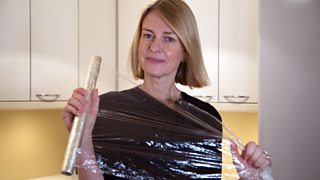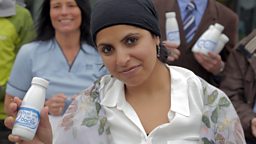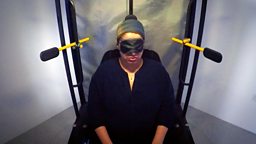Is it safe to use cling film in the microwave?
After receiving a number of enquiries from viewers about whether it’s safe to use cling film in the microwave, we decided to investigate.

Making any kind of plastic is complicated and lots of different chemicals are used. In Europe, just over 900 chemicals are permitted for use in plastics that come into contact with food.
We know that some of these chemicals can migrate from the plastics into food, but there are strict limits on how much of this migration is acceptable.
The Test
For our test, we purchased cling films made with PVC and marked as “microwave safe” and sent them to Dr Emma Bradley at FERA Science Ltd for analysis.
Emma found that our cling film sample contained a chemical called Epoxidized Soybean Oil, or ESBO, that is commonly used in the manufacture of plastics. This chemical is approved for use and there are standard tests available that can tell us if it gets into food during cooking. Knowing how much ESBO can get into food, is considered to be a good overall measure of the risk of other chemicals migrating into food.
ESBO is a chemical that dissolves well in fatty substances, so the risk of it getting into food is greatest when it’s cooked with fatty foods. So Emma tested our cling film in a ‘real life scenario’ by microwaving it with a very fatty food– a spaghetti carbonara ready-meal.
She also tested the cling film in what can be described as a ‘worst case scenario’. This involved soaking it in olive oil (another very fatty substance) before placing it in a 100°C oven for 30 minutes. This test was designed to mimic the conditions of microwave cooking.
The results
Both the oil and the spaghetti carbonara were analysed to see if any ESBO had been transferred to them from the cling film. We found that some transfer did take place in the ‘worst case scenario’ olive oil test, but this transfer was within legal limits. No transfer was detected from the cling film to the carbonara in our ‘real life’ test.
What does this mean?
Our tests didn’t find anything that transgressed EU law, which suggests that it is safe to use cling film in the microwave. However to keep any risk of transfer to a minimum, it’s advisable to make sure that your cling film isn’t in direct contact with your food when you microwave it.
While the Food Standards Authority in the UK does not have specific recommendations about microwaving with cling film, the Irish and American equivalents do. The Food Safety Authority of Ireland and The United States Department of Agriculture both advise that cling film should not touch food during cooking.
When using cling film, you can also check the packaging for any specific instructions, but interestingly you don’t have to choose cling film that is labelled ‘microwave safe’. Unless a cling film is specifically marked as not safe for microwave use, it must be suitable for use in the microwave under EU law.





























